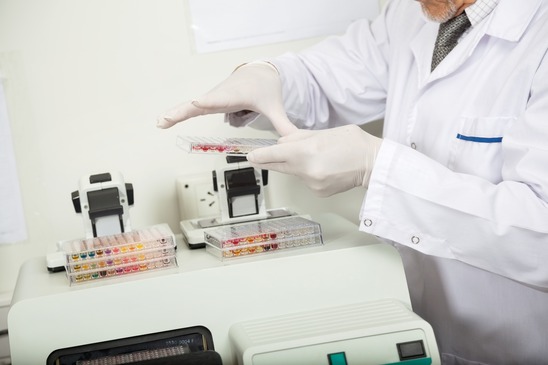Intro To Plate Readers
 Microplate readers are also referred to as plate readers are laboratory instruments designed to detect biological, chemical or physical events in microplates¹ via the measurements of light. Plate readers are commonly found in many laboratories and are widely used for many applications across a wide range of disciplines, including life sciences, research, drug discovery, bioassay validation, quality control and manufacturing processes in the biopharmaceutical/pharmaceutical and biotechnology industry as well as academic organizations.
Microplate readers are also referred to as plate readers are laboratory instruments designed to detect biological, chemical or physical events in microplates¹ via the measurements of light. Plate readers are commonly found in many laboratories and are widely used for many applications across a wide range of disciplines, including life sciences, research, drug discovery, bioassay validation, quality control and manufacturing processes in the biopharmaceutical/pharmaceutical and biotechnology industry as well as academic organizations.
Most Common Microplate Format
The 96-well format microplate is the most common well format used in academic research laboratories and clinical diagnostic laboratories with a typical reaction volume between 100 and 200 µL per well.
High-Throughput Screening Applications
384- and 1536-well format microplates (assay volume between 5 and 50 µL per well) have a higher density and are typically used for HTS and uHTS screening applications, when throughput or the number of samples per day processed and assay cost per sample become critical parameters.
Microplate Readers On The Market
Plate readers are part of a very well established product category and are continuing to evolve as new technologies develop. Microplate readers are gaining greater functionality, flexibility, speed and throughput. There are a wide variety of plate reader manufacturers (sampling listed below) that offer an even larger selection of microplate readers on the market with varying capabilities and functionalities.
Microplate Reader Manufacturers
The list of manufacturers below represent a sampling of the variety of microplate readers available on the market. When selecting a microplate reader or a specific brand of microplates it is important to ensure that both the consumable and instrumentation are compatible.
- Analytik Jena AG
- Berthold Detection Systems GmbH
- BERTHOLD TECHNOLOGIES GmbH & Co.KG
- BioTek Instruments GmbH
- BMG LABTECH GmbH
- STRATEC Biomedical Systems AG
- Tecan
Detection Modes
One of the key differentiators of microplate readers is the type of detection mode they offer.
Common Types
- Absorbance
- Fluorescence
- Luminescence
Additional Detection Modules
- Fluorescence resonance energy transfer (FRET)
- Time-resolved fluorescence (TRF)
- TR-FRET
- Fluorescence polarization
- Bioluminescence resonance energy transfer (BRET)
- AlphaScreen
- Nephelometry
Another difference in microplate readers is the technology used in these detection modes previously discussed.
Absorbance² measurements can be performed with:
- Filters
- Monochromators
- Spectometer
Filter and monochromator-based instruments capture wavelengths one wavelength at a time compared to newer spectrometer-based readers which capture an entire spectrum of wavelengths.
Fluorescence³ measurements can be performed with either:
- Filters
- Monochromators
Advantages Of Detection Modes
- Filters (sensitivity)
- Monochromators (flexibility)
- New Linear Variable Filter Monochromators (sensitivity and flexibility)
- Lasers (used in place of a flash lamp) e.g. TRF and AlphaScreen Measurements
*Caveat: Different microplate readers may utilize different technologies for the various detection modes
Microplate Reader Types
- Single-mode readers; e.g. absorbance, fluorescence intensity or luminescence detection
- Multimode readers, combine several read modes and allow researchers to perform multiple assay types in one system, typically more expensive than the single-mode readers but take up less space.
In the next post on microplate readers we will be covering the types of applications you will be measuring depending on your field of research. If you currently have a microplate reader and are looking for instrument compatibility with microplates please feel free to request a complimentary sample to test in your laboratory.
Leave a Reply
You must be logged in to post a comment.